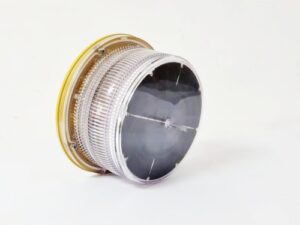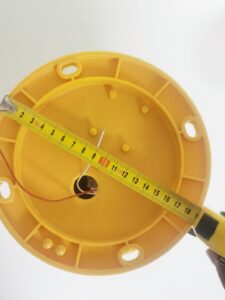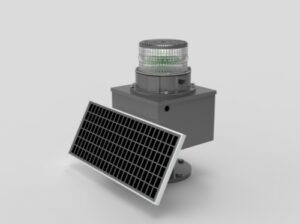Aviation obstruction lights are essential safety features for tall buildings, ensuring that they are visible to aircraft, particularly at night or in low-visibility conditions. They are categorized based on the structure’s dimensions and altitude, and their primary goal is to prevent aerial collisions.
Q: What are aviation obstruction lights?
A: They are safety lights installed on tall structures to make them visible to aircraft, reducing the risk of aerial collisions.

CHAPTER 5. RED OBSTRUCTION LIGHT SYSTEM
5.7 Prominent Buildings, Bridges, and Similar Extensive Obstructions.
When objects within a group of obstructions are approximately the same overall height above the surface and are located a maximum of 150 feet (45.72 m) apart, the group of obstructions may be considered an extensive obstruction. Light units should be installed on the same horizontal plane at the highest portion, or edge, of the prominent obstructions. Light units should be placed to ensure the light is visible to a pilot approaching from any direction. If the structure is a bridge (see Figure A-8) and is over navigable water, the sponsor must obtain prior approval of the lighting installation from the Commander of the District Office of the U.S. Coast Guard to avoid interference with marine navigation. Steady-burning lights should be displayed to indicate the extent of the obstruction as follows:
1. Structures 150 feet (45.72 m) or less in any horizontal direction. If the structure/bridge/extensive obstruction is 150 feet (45.72 m) or less horizontally, at least one steady-burning light (L-810) should be displayed on the highest point at each end of the obstruction’s major axis. If this is impractical because of the overall shape, display a double obstruction light in the center of the highest point.
2. Structures exceeding 150 feet (45.72 m) in at least one horizontal direction. If the structure/bridge/extensive obstruction exceeds 150 feet (45.72 m) horizontally, at least one steady-burning light should be displayed for each 150 feet (45.72 m), or fraction thereof, of the overall length of the major axis. At least one of these lights should be displayed on the highest point at each end of the obstruction. Additional lights should be displayed at approximately equal intervals, not to exceed 150 feet (45.72 m) on the highest points along the edge between the end lights. If an obstruction is located near a landing area and two or more edges are the same height, the edge nearest the landing area should be lighted.
3. Structures exceeding 150 feet (45.72 m) AGL. Steady-burning red obstruction lights should be installed on the highest point at each end. At intermediate levels, steady-burning red lights should be displayed for each 150 feet (45.72 m), or fraction thereof. The vertical position of these lights should be equidistant between the top lights and the ground level, as the shape and type of obstruction will permit. A steady-burning red light should be displayed at each outside corner on each level with the remaining lights evenly spaced between the corner lights.
4. Exceptions. Flashing red lights (L-864) may be used instead of steady-burning lights if early or special warning is necessary. These lights should be displayed on the highest points of an extensive obstruction at intervals not exceeding 3,000 feet (914.40 m). At least three lights should be displayed on one side of the extensive obstruction to indicate a line of lights.
5. Ice Shields. Where icing is likely to occur, metal grates or similar protective ice shields should be installed directly over each light unit to prevent falling ice or accumulation from damaging the light units. The light should be mounted in a manner to ensure an unobstructed view of at least one light by a pilot approaching from any direction.
5.8 Group of Obstructions.
With the exception of wind turbines, when individual structures within a group of obstructions differ in height and are spaced no more than 150 feet (45.72 m) apart, the prominent structures within the group should be lighted in accordance with the standards for individual obstructions based on its corresponding height. Shorter structures within the group of obstructions do not need to be lighted. When structures are shorter than the prominent structure and are located on the outside of the group of obstructions, those structures should be lighted in accordance with the standards for individual obstructions based on its corresponding height. In addition to lighting the shorter structures on the outside of the group, at least one flashing light should be installed either at the top of the tallest, most prominent center structure, or on a dedicated tower that is located near the center of the group and is the same height as the most prominent structure. Light units should be placed on the structures to ensure that the lights are visible to a pilot approaching from any direction. If one or more of the structures within the group are a solid mass (non- skeletal), additional lighting may be necessary to make sure that the light is not being blocked by the more prominent structure(s). For the purpose of marking and lighting these structures, a group of obstructions is considered to be three or more structures.
CHAPTER 6. MEDIUM-INTENSITY FLASHING WHITE OBSTRUCTION LIGHT SYSTEMS
6.6 Prominent Buildings and Similar Extensive Obstructions.
With the exception of wind turbines, when objects within a group of obstructions are
approximately the same overall height above the surface and are located a maximum of 150 feet (45.72 m) apart, the group of obstructions may be considered an extensive obstruction. Light units should be installed on the same horizontal plane at the highest portion, or edge, of the prominent obstructions. Light units should be placed to ensure that the light is visible to a pilot approaching from any direction. Lights should be displayed to indicate the extent of the obstruction as follows:
1. Structures 150 feet (45.72 m) or less in any horizontal direction. If the structure/extensive obstruction is 150 feet (45.72 m) or less horizontally, at least one light should be displayed on the highest point at each end of the obstruction’s major axis. If this is impractical because of the overall shape, display a double obstruction light in the center of the highest point.
2. Structures exceeding 150 feet (45.72 m) in at least one horizontal direction. If the structure/extensive obstruction exceeds 150 feet (45.72 m) horizontally, at least one light should be displayed for each 150 feet (45.72 m), or fraction thereof, of the overall length of the major axis. At least one of these lights should be displayed on the highest point at each end of the obstruction. Additional lights should be displayed at approximately equal intervals not to exceed 150 feet (45.72 m) on the highest points along the edge between the end lights. If an obstruction is located near a landing area and two or more edges are the same height, the edge nearest the landing area should be lighted.
3. Structures exceeding 150 feet (45.72 m) AGL. Lights should be installed on the highest point at each end. At intermediate levels, lights should be displayed for each 150 feet (45.72 m), or fraction thereof. The vertical position of these lights should be equidistant between the top lights and the ground level as the shape and type of obstruction will permit. One such light should be displayed at each outside corner on each level with the remaining lights evenly spaced between the corner lights.
CHAPTER 7. HIGH-INTENSITY FLASHING WHITE OBSTRUCTION LIGHT SYSTEMS
7.9 Prominent Buildings and Similar Extensive Obstructions.
When objects within a group of obstructions are approximately the same overall height above the surface and are located a maximum of 150 feet (45.72 m) apart, the group of obstructions may be considered an extensive obstruction. Light units should be placed to ensure that the light is visible to a pilot approaching from any direction. These lights may require shielding, such as louvers, to ensure minimum adverse impact on local communities.
Light units should be installed on the same horizontal plane at the highest portion or edge of the prominent obstructions and displayed to indicate the extent of the obstruction as follows:
1. Obstructions 200 feet (60.96 m) or less in either horizontal dimension. Three or more light units should be installed at the highest portion of the structure to ensure that at least one light is visible to a pilot approaching from any direction. Light units may be mounted on a single pedestal at or near the center of the obstruction. If the light units are placed more than 10 feet (3.05 m) from the center point of the structure, use a minimum of four light units.
2. Obstruction exceeds 200 feet (60.96 m) in one horizontal dimension, but is 200 feet (60.96
m) or less in the other. Two light units should be placed on each of the shorter sides. These light units may be installed either adjacent to each other at the midpoint of the obstruction’s edge or at (near) each corner, with the light unit aimed to provide 180 degrees of coverage at each edge. One or more light units should be installed along the overall length of the major axis at approximate equal intervals, not to exceed a distance of 100 feet (30.48 m) from the corners or from each other.
3. Obstruction exceeds 200 feet (60.96 m) in both horizontal dimensions. The light units should be equally spaced along the overall perimeter of the obstruction at intervals of 100 feet (30.48 m), or fraction thereof.





